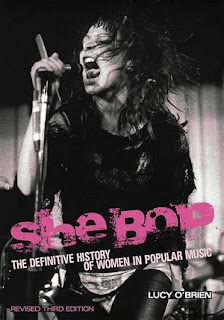Last year, a friend posted on Twitter: “I’d like some big sprawling pop history books written by women now, please.” Obviously, it caused a bit of a discussion.
And it made me wonder. I like books, and I particularly like music books written by women, but I don’t think I like sprawling books. And I wondered if I actually like the word “sprawling” either. It feels like a male word. A word for people who are used to taking up space, regardless. More space than is actually necessary. Maybe a sprawling book is the literary version of manspreading. I can’t think of many books by women that do that.
There are some long pop history books by women, but that’s not the same as being sprawling. She Bop (25th Anniversary Edition) by Lucy O’Brien is one example. It’s 423 pages long and it’s the opposite of sprawling. Because there’s a lot to fit in, so it has to be concise.
It is, after all, subtitled “The definitive history of women in popular music”. And, in case you hadn’t noticed, that’s a lot of history. The original was published in 1995; after three editions this is the “revised and updated 25th anniversary edition” with even more women to write about. (“The “updated” aspect is interesting; we’ll come to that later.)
It’s partly chronological, mostly thematic. You start in the early 20th century with blues and jazz – singers, yes (the usual suspects and some you might not have heard of) but also instrumentalists and bandleaders. Women’s history is two steps forward, one step back. So after British bandleader Ivy Benson’s success (and autonomy) during the war years, we are back to decorative soloists in the 1950s: “Bouncy trivia” sung by “babydoll stylists”. And then there’s the 1960s…
I loved the discussion of the “mythic status” of girl groups, the interview with legendary songwriter Ellie Greenwich, and being reminded of how great the Shangri-Las were. And then there’s punk, my favourite chapter obviously, describing an era of “political and feminist debates” and “women’s eccentricity”.
And so it continues..
The great thing about this book is the lack of barriers. Black women and white women co-exist in the same chapters. Links are made between different times and places. All genres are covered – this is “popular music “not “rock” so you get rock chicks, singer-songwriters, gospel and soul, disco divas, folk and protest, global music, rap and reggae.
Each of these gets a feminist perspective. Who has the power? Who makes the decisions? Who and what decided the success or longevity of these women’s careers? Themselves, men, the wider culture? And, always, what about the perennial “Image Question” that doesn’t seem to be an issue for male musicians?
Then there’s the question of women’s relationship to pop and rock music itself. On one hand you’ve got the Keith Richards wannabes like Chrissie Hynde; on the other you’ve got Lydia Lunch declaring “Get rid of the fucking raunchy bad rock’n’roll!” There are choices: play by the rules, break the rules, make up your own rules. Music doesn’t have to be a man’s world.
From a business point of view, though, it still is. Like any business. And in the chapter about women working in the business, there’s a lot to make you cross. But later, in the updated part, it starts to get interesting. Because if the original book was angry about “the invisibility of women in all aspects of the industry”, the new one is more hopeful.
There is still a lot to be angry about, but there are signs that things might be changing. As the story moves into the 21st century, there are signs that music is a vehicle for feminism again. Not only that, but new technology is giving women control of the tools of production – and distribution. Which means autonomy for female musicians is, finally, a possibility.
And as the author looks back over a history of constant marginalisation and resistance, she identifies a story arc of “a continual process of becoming, finding ways to contest those patriarchal traps”.
It’s a huge story, a huge labour of love (270 interviews, plus secondary sources), and a huge achievement.
And there’s a huge amount of information in there. There are, after all, a lot of women to write about. So many in fact that some of the namechecks are just lists: the opposite of sprawling. If there’s a fault in the book, it’s that there are so many women’s voices to be heard that there isn’t much space for the author’s voice. She is more generous to other women than to herself.
To get a sense of the author’s own history and personality you need to read the prologue, an evocative mini-memoir about O’Brien’s shortlived schoolgirl punk band The Catholic Girls. And her realisation, when it was all over, that “no one told us that there were other girls out there too.”
This is what this book does: it reminds us that there are other women out there making music: good music, innovative music, important music. There always have been. And there always will.




No comments:
Post a Comment